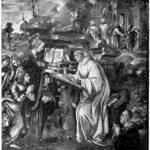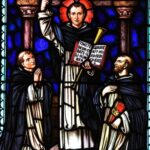St. Luke
St. Luke
When They Lived
St. Luke, the revered figure whose contributions have had a lasting impact on both the Christian faith and the world at large, is believed to have lived during the 1st century AD. While the exact years of his birth and death are not definitively known, his influence and legacy endure to this day.
Where They Lived
St. Luke is traditionally associated with the city of Antioch, a thriving cultural and commercial hub in the ancient region of Syria. Antioch’s diverse population and dynamic atmosphere would have provided an enriching environment for a figure like St. Luke to flourish.
Notable World Events During Their Time
- The Pax Romana: St. Luke’s lifetime coincided with the Pax Romana, a period of relative peace and stability within the Roman Empire. This era facilitated the spread of ideas, cultures, and religions, contributing to the dissemination of Christianity.
- The Great Fire of Rome (64 AD): The devastating fire that swept through Rome during Nero’s reign left an indelible mark on history. This event led to accusations against early Christians, underscoring the challenges they faced and the resilience they exhibited.
- The Destruction of the Second Temple (70 AD): A cataclysmic event for Judaism, the Roman siege and destruction of the Second Temple in Jerusalem had far-reaching implications for both religious traditions and the political landscape of the time.
- The Life of Apostle Paul: St. Luke is famously associated with the Apostle Paul, whose journeys and teachings played a pivotal role in shaping early Christianity. The duo’s interactions and collaboration have left an indelible mark on the Christian faith.
- Scientific Advancements: St. Luke’s life was a witness to the advancement of scientific knowledge. While not directly tied to his work, this period saw the blossoming of Greek and Roman scientific endeavors, contributing to the foundation of modern scientific thought.
Their Patronage
St. Luke is celebrated as the patron saint of a wide array of professions and causes. While he is most commonly associated with physicians, artists, and surgeons due to his identity as both a physician and an evangelist, his patronage extends beyond these domains. Writers, historians, painters, and even those suffering from illnesses find solace in seeking his intercession. St. Luke’s multifaceted identity and diverse patronage make him a source of inspiration and comfort for people from all walks of life.
Intriguing Insights
Beyond his religious contributions, St. Luke’s life serves as a reminder of the interconnectedness of history, faith, and culture. His Gospel and the Book of Acts provide valuable insights into the early Christian community and the challenges it faced, offering a lens through which we can better understand the foundations of Christianity. St. Luke’s ability to bridge the spiritual and the practical, the scientific and the divine, makes him a figure whose legacy continues to captivate and inspire, transcending time and boundaries.
The Evangelist
There are no extant writings about the early life of St. Luke. However, the Church historian Eusebius tells us that Luke was born in Antioch and was a Gentile. We know nothing of the circumstances of the conversion of Luke.
The third of the four Gospels is attributed to St. Luke. He never met Christ in person. However, in his Gospel, Luke says that he came to a knowledge of Jesus by talking to eyewitnesses to the events of the life, death and resurrection of Jesus. Listening to these stories helped him to become a believer himself, and he penned his version of the Gospel so that others would come to know, believe and love Jesus. He also wrote the Acts of the Apostles. In it, we learn about the coming of the promised Holy Spirit, the work and mission of the Apostles, especially St. Paul, and how the Church grew in the world.
Paul’s Faithful Companion
Luke’s name appears in the Acts of the Apostles. He was a companion of St. Paul and traveled with him on his second missionary journey. We can deduce that he really joined Paul by reading the Acts of the Apostles. The first up to the sixteenth chapter of the Acts of the Apostles were written in the third person. However, in the succeeding parts of it, it suddenly passed to the first person plural: “During [the] night Paul had a vision. A Macedonian stood before him and implored him with these words, ‘Come over to Macedonia and help us.’ When he had seen the vision, we sought passage to Macedonia at once, concluding that God had called us to proclaim the good news to them.” (Acts 16:9-10)
After this, Luke then accompanied Paul to Samothrace, Neapolis and Philippi around the year 51. Another passage in the third person leads the reader to think that Luke was not arrested with Paul, but rather stayed in Philippi after his friend left. When Paul was arrested and imprisoned in Rome in the year 61, Luke remained at his side as can be seen from the Epistles of Paul to Philemon and to Timothy. After being left by all, in the last phase of his imprisonment, Paul wrote to Timothy and told him that “only Luke is with me” (2 Timothy 4:11).
The Beloved Physician
Luke was a physician. This was, in fact, proven by no less than St. Paul himself when he called Luke as the “beloved physician” (Colossians 4:14). No wonder why in his account of the Gospel, Luke helps his readers know how Jesus was concerned for the sick, the poor and those who are in need of help, forgiveness and mercy. Through his Gospel, we learn how compassionate and caring Jesus was.
The details of the death of Luke are uncertain. Some sources say he suffered martyrdom. Others say he lived to old age. The oldest traditions say Luke settled in Boeotia where he wrote the Gospel and died at age 84. His relics are found in the Abbey of Santa Giustina in Padua, a rib from his body was sent to his original tomb in Thebes and his skull is preserved in the Cathedral of St. Vitus in Prague. His feast day is October 18.
Five Interesting Facts About St. Luke
- St. Luke is the patron saint of doctors and physicians.
- St. Luke is also the patron saint of artists. It is believed that he painted a famous portrait of Mary, our Blessed Mother.
- The symbol for St. Luke’s Gospel is an ox. An ox was often sacrificed as an offering to God in the Biblical times. In his writings, St. Luke reminds his readers of the sacrifice of Jesus to save all people through His death and resurrection.
- Among the four Gospel accounts, the Gospel according to Luke is the longest. One might think that Matthew’s was the longest, but the Gospel of Luke “extends” its story to the Acts of the Apostles as its second part since they were both authored by St. Luke.
- It is only in the Gospel according to Luke that we could find three parables consecutively written. These were the parables of the lost sheep, lost coin and the lost son. They are all found in chapter 15.
Prayer to St. Luke
Lord God, who chose Saint Luke to reveal by his preaching and writings the mystery of your love for the poor, grant that those who already glory in your name may persevere as one heart and one soul and that all nations may merit to see your salvation.Through our Lord Jesus Christ, your Son, who lives and reigns with you in the unity of the Holy Spirit, one God, for ever and ever. Amen.



